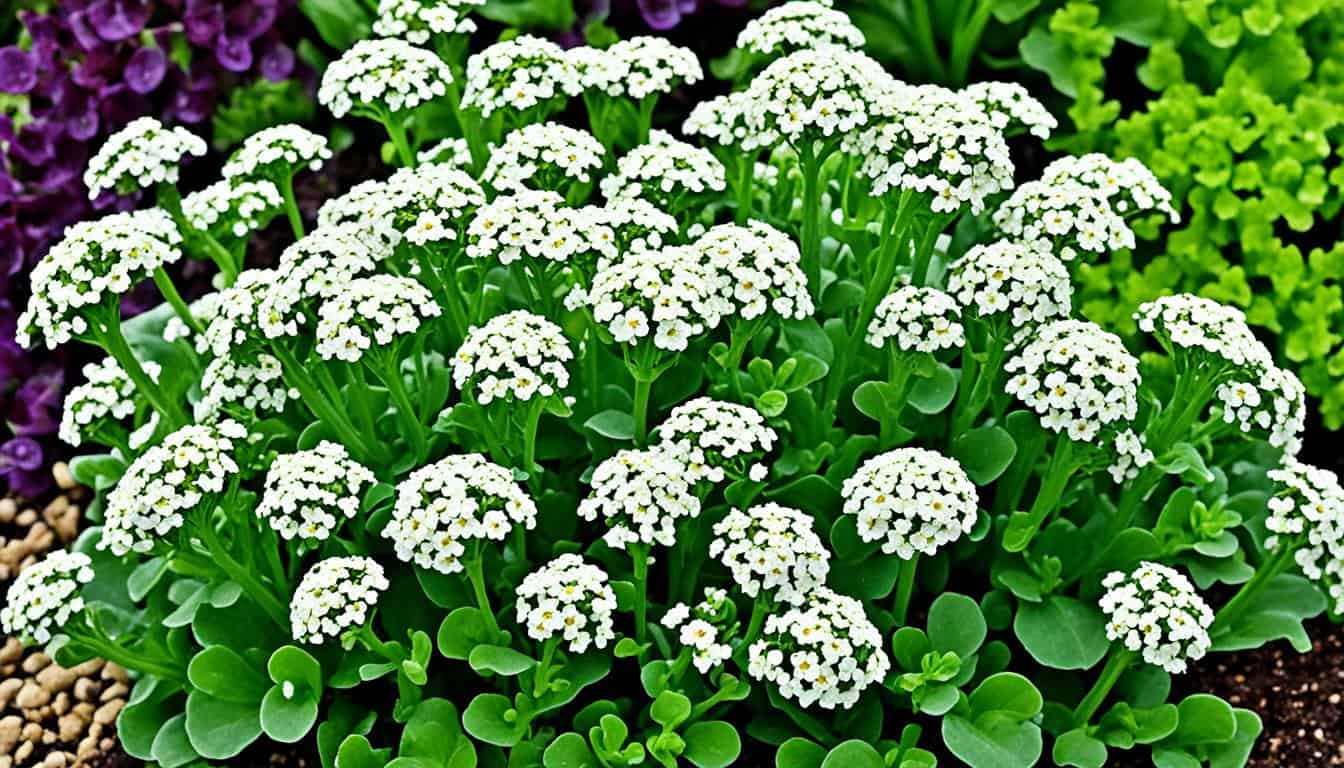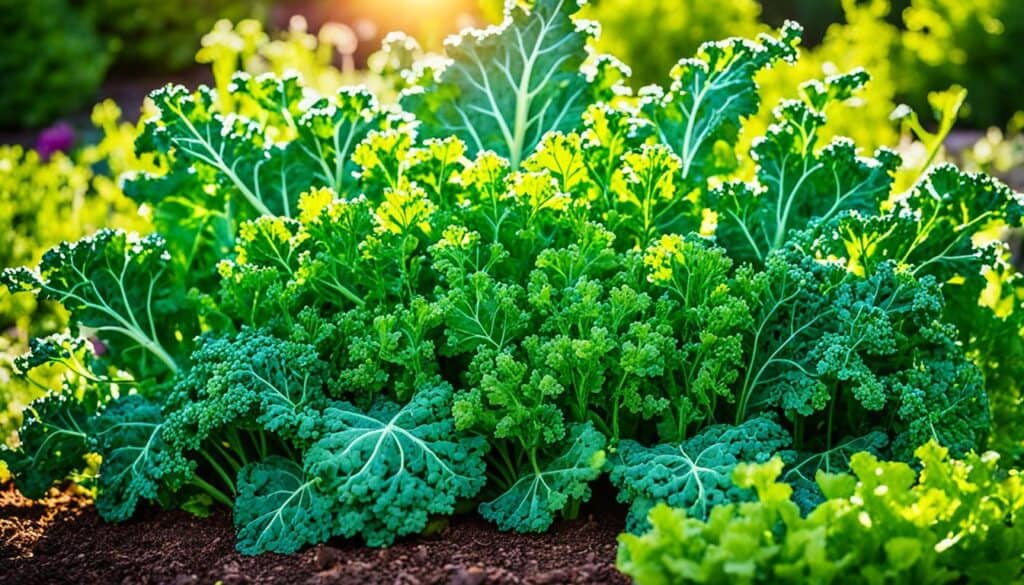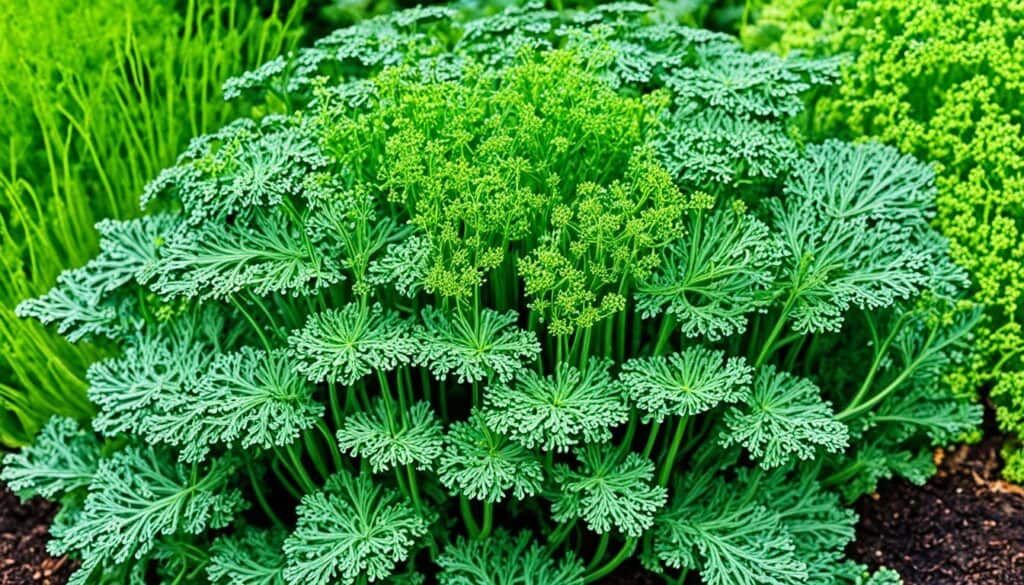Did you know that companion planting can significantly enhance the health and productivity of your kale plants? By strategically selecting the right companion plants, you can create a thriving ecosystem in your garden while protecting your kale from pests.
Companion planting is an age-old gardening technique that involves planting certain flowers, herbs, and vegetables together to promote synergy and mutual benefits. It can improve soil quality, attract beneficial insects, and repel pests, creating an optimal environment for kale to flourish.
In this article, I will guide you through the best companion plants for kale, providing you with a comprehensive companion planting guide to help you make the most of your garden. Together, we’ll explore the recommended plants to grow with kale, ideal companion plants for kale, and the many benefits of companion planting.
Key Takeaways:
- Companion planting enhances the resilience and productivity of your kale garden.
- Selecting the right companion plants can attract beneficial predators and repel pests.
- Sweet alyssum, African marigolds, and calendula are effective companion plants for pest control.
- Cilantro and dill repel pests while adding aromatic flavors to your garden.
- Other beneficial companion plants for kale include rosemary, catnip, and chives.
The Benefits of Companion Planting
Companion planting is not only an ecological growing method but also offers a range of benefits for your garden. By strategically pairing plants, you can create a symbiotic relationship that maximizes the resilience and productivity of your garden while reducing the need for pesticides or organic sprays.
Companion planting attracts beneficial predators that eat pests, enhances pollination by attracting pollinators, fixes nitrogen in the soil, out-competes weeds, and improves soil quality.
One of the major advantages of companion planting is higher yields. By diversifying the plant species in your garden, you can create a more robust and balanced ecosystem, leading to healthier plants and increased harvest. The combination of different plants can help prevent the spread of diseases and reduce overall pest pressure.
Additionally, this ecological growing method offers ecosystem benefits. By introducing a variety of plants, you attract a broader range of insects and wildlife, contributing to biodiversity and creating a more resilient garden ecosystem. This balance not only supports the growth of your kale but also benefits the surrounding plants.
Companion planting can also help reduce pest pressures. Certain plant combinations can repel pests, while others attract predatory insects that feed on harmful pests. By deploying this natural defense strategy, you can minimize pest damage without relying on chemical interventions.
To summarize, the benefits of companion planting include:
- Higher yields
- Less pest pressures
- Improved ecosystem balance
Next, let’s explore specific companion plants that work well with kale to maximize these benefits.
Companion Plants for Pest Control
Certain companion plants have been scientifically proven to be effective in repelling pests and reducing aphid pressure in kale plantings. By strategically incorporating these companion plants into your garden, you can attract beneficial predators that control pests and create a more balanced ecosystem. This not only helps protect your kale but also promotes healthier and more productive growth.
Sweet Alyssum
Sweet alyssum is one such companion plant that attracts beneficial predatory insects, such as lacewings and parasitic wasps, which are natural enemies of pests like aphids. By planting sweet alyssum alongside your kale, you can naturally repel aphids and reduce infestations. The low-growing habit of sweet alyssum makes it an ideal choice for planting alongside kale without competing for light or nutrients. Start by growing sweet alyssum indoors early and then transplant it into your garden for maximum benefits.
African Marigolds
African marigolds are another effective companion plant for kale. They not only repel pests like aphids but also deter root knot nematodes. Additionally, African marigolds attract pollinators like wasps, which prey on aphids and help control their population. Consider planting French Marigolds for companion planting, as they have a more compact growth habit. You can either plant marigolds around the perimeter of your kale bed or alternate them throughout the rows to optimize pest control.
Calendula
Another lesser-known yet beneficial companion plant for kale is calendula, also known as pot marigold. Calendula attracts beneficial predator insects like hoverflies, lacewings, and ladybugs, which help control pests such as aphids and thrips. It blooms during the cool spring weather, so it can be planted alongside kale rows or at row ends to provide protection throughout the growing season.
These companion plants not only repel pests and reduce aphid pressure but also attract beneficial predators that keep pest populations in check. By incorporating them into your garden, you can create a more balanced ecosystem and protect your kale from unwanted pests.
Sweet Alyssum as a Kale Companion Plant
Sweet alyssum is an excellent companion plant for kale. Its delicate flowers and sweet fragrance attract beneficial predatory insects, such as lacewings and parasitic wasps, which feed on pests like aphids. By planting sweet alyssum alongside kale, you can create a diverse ecosystem that helps repel aphids and promote a healthy garden.
The low-growing habit of sweet alyssum makes it a perfect companion for kale. It doesn’t compete with kale for light or nutrients, allowing both plants to thrive side by side. When planted in close proximity, sweet alyssum acts as a sacrificial crop, attracting pests away from the kale and providing a food source for beneficial insects.
To maximize the benefits of sweet alyssum as a companion plant, consider starting the seeds indoors early and transplanting them into the garden. This will give the plants a head start and ensure they are well-established by the time you plant the kale. Make sure to provide ample space between the sweet alyssum and kale plants to allow for proper growth.
Benefits of Sweet Alyssum as a Kale Companion Plant:
- Attracts beneficial predatory insects like lacewings and parasitic wasps
- Helps control aphid populations
- Creates a diverse ecosystem in the garden
- Doesn’t compete with kale for light or nutrients
- Acts as a sacrificial crop to distract pests
By incorporating sweet alyssum as a companion plant for kale, you can enhance pest control in your garden and promote a healthy growing environment. The beneficial insects attracted to sweet alyssum will help naturally repel aphids and other pests, reducing the need for chemical pesticides. Embrace the power of companion planting and enjoy the beauty and benefits of sweet alyssum alongside your kale crop.
African Marigolds as a Kale Companion Plant
African marigolds are an excellent choice as companion plants for kale. Not only do they add a splash of vibrant color to your garden, but they also help repel common pests such as aphids and root knot nematodes. By planting African marigolds alongside your kale, you can create a natural deterrent to these destructive insects.
But that’s not all! African marigolds also attract pollinators like wasps, which are natural enemies of aphids. By inviting these beneficial insects into your garden, you can establish a healthy balance and naturally control pest populations.
When choosing African marigolds for companion planting, opt for French Marigolds as they have a more compact growth habit, making them an ideal choice for planting alongside kale.
| Benefits of African Marigolds as Kale Companion Plants | How to Optimize Placement |
|---|---|
|
|
By strategically placing African marigolds around your kale plants, you can create a barrier that deters pests from reaching your precious kale crop. This companion planting technique not only protects your kale but also contributes to the overall health and vitality of your garden.
In addition to their pest-repellent properties, African marigolds attract pollinators, ensuring a bountiful harvest. The presence of pollinators like wasps helps increase the chances of successful pollination, leading to healthy and robust kale plants.
So, if you’re looking for a beautiful companion plant that repels pests and attracts pollinators, African marigolds are an excellent choice for planting alongside your kale.
Calendula as a Kale Companion Plant
Calendula, also known as pot marigold, is an excellent companion plant for kale. Not only does it add a pop of vibrant color to your garden, but it also offers a range of benefits for your kale crop.
Attract Beneficial Predators
One of the key advantages of planting calendula alongside kale is its ability to attract beneficial predator insects. Calendula flowers act as magnets for hoverflies, lacewings, and ladybugs, which are natural enemies of common kale pests such as aphids and thrips. These helpful insects help curb pest populations, promoting a healthier kale crop without the need for chemical pesticides.
Control Aphids and Thrips
Aphids and thrips are notorious pests that can wreak havoc on kale plants, causing stunted growth and leaf damage. By planting calendula nearby, you create an environment that naturally discourages these pests. The scent and nectar of calendula flowers repels aphids and thrips, reducing the likelihood of infestation and protecting your kale from damage.
Cool Spring Weather Blooms
Calendula is well-known for its ability to thrive in cool spring weather. This makes it an ideal companion plant for kale, as they both prefer similar growing conditions. When planted alongside kale rows or at row ends, calendula creates a beautiful and functional barrier that protects your kale from pests throughout the growing season.
Calendula is a beautiful, multi-purpose companion plant that not only enhances the aesthetic appeal of your garden but also works tirelessly to attract beneficial predators and keep aphids and thrips at bay.
With its ability to attract beneficial predators, control pests, and thrive in cool spring weather, calendula is a must-have companion plant for kale. By incorporating calendula into your garden, you can create a harmonious and resilient ecosystem that supports the growth and vitality of your kale crop.
Cilantro as a Kale Companion Plant
When it comes to companion planting with kale, cilantro is a versatile and beneficial herb to consider. Not only does cilantro add a burst of flavor to your dishes, but it also offers numerous advantages when grown alongside kale.
One of the key benefits of cilantro as a companion plant is its ability to repel pests. Cilantro’s fragrant leaves act as a natural deterrent to pests like aphids, spider mites, and potato beetles, helping to protect your kale crop from potential damage.
Additionally, cilantro attracts beneficial insects that can help control aphid populations in your garden. Parasitoid wasps are particularly attracted to the fragrant flowers of cilantro, and they feed on aphids, which can be destructive to kale plants. By planting cilantro near your kale, you can create a welcoming habitat for these helpful insects.
One way to maximize the benefits of cilantro as a companion plant is to sow a row of cilantro between each row of kale. This strategic placement allows cilantro to create a barrier around your kale plants, further deterring pests and attracting beneficial insects.
| Benefits of Cilantro as a Kale Companion Plant |
|---|
| Repels pests like aphids, spider mites, and potato beetles |
| Attracts beneficial insects, including parasitoid wasps |
| Creates a barrier around kale plants for enhanced pest control |
| Provides a flavorful addition to culinary dishes |
Another advantage of growing cilantro alongside kale is the opportunity to enjoy its fragrant leaves. Cilantro leaves can be harvested before the plant starts to bolt in warmer weather, ensuring a fresh supply of this flavorful herb for your cooking needs.
To get started with cilantro companion planting, sow cilantro seeds directly into the soil near your kale plants. Cilantro prefers well-draining soil and partial shade, so choose a location that meets these requirements.
Remember, while cilantro is a fantastic companion for kale, it’s essential to consider the needs of your kale plants as well. Ensure that the companion plants you choose do not compete with your kale for sunlight, water, or nutrients. Striking the right balance between companions is crucial for successful gardening.
By incorporating cilantro into your kale garden, you can reap the benefits of natural pest control, attract beneficial insects, and enjoy the aromatic flavors of this versatile herb.
Dill as a Kale Companion Plant
When it comes to companion plants for kale, dill is a true gem in the garden. Not only does it add a delightful aroma to your outdoor space, but it also provides a range of benefits to your kale plants.
One of the key advantages of planting dill alongside kale is its ability to attract predatory insects that help control pests. The flowers of dill act as a magnet, drawing in beneficial insects like hoverflies, ladybugs, and lacewings. These predators feed on common kale pests such as aphids, creating a natural and effective solution to pest control.
In addition to pest management, dill can also enhance the growth of nearby freshly transplanted vegetables. The young dill plants release organic compounds into the soil, which promote the growth of neighboring plants, including kale. This symbiotic relationship between dill and kale contributes to the overall health and vitality of your garden.
Planting dill is a straightforward process. Wait until the danger of frost has passed, and either sow dill seeds directly into the ground or transplant seedlings into your garden. Dill is a low-maintenance herb that thrives in full sun and well-drained soil.
As a bonus, dill leaves and seeds are flavorful additions to your culinary adventures. The feathery leaves can be used as a fresh herb to enhance the taste of salads, dressings, and sauces. Dill seeds, on the other hand, add a distinctive flavor to pickles, seafood, and various dishes.
By adding dill as a companion plant for your kale, you not only support the growth and resilience of your kale crop but also enjoy the added benefit of flavorful harvests to enhance your culinary creations.
Give dill a try in your garden and experience the advantages it brings to both your kale plants and your taste buds.
| Benefits of Dill as a Kale Companion Plant | Growing Tips for Dill |
|---|---|
|
|
Other Beneficial Companion Plants
In addition to the mentioned companion plants, there are other beneficial options for planting alongside kale. By incorporating these companion plants, you can further enhance the pest control and growth of your kale.
Rosemary
Rosemary is not only a flavorful herb but also a beneficial companion plant for kale. Its strong fragrance repels aphids, keeping them away from your kale plants. Consider planting rosemary near your kale beds to improve pest control and create a pleasant aroma in your garden.
Catnip
Catnip is another excellent companion plant choice for kale. Not only does it attract pollinators like bees and butterflies, but it also draws beneficial insects such as lacewings and parasitic wasps. These predatory insects help control aphid populations in your garden, improving pest control naturally.
Chives
If you’re looking for a companion plant that not only deters pests but also adds flavor to your meals, chives are a great option. Chives have a strong scent that can deter pests like aphids and attract pollinators to your garden. Plus, they are easy to grow and make a tasty addition to various dishes.
Experimenting with these beneficial companion plants, such as rosemary, catnip, and chives, can enhance the overall health and productivity of your kale garden. By attracting beneficial insects and repelling pests, you can enjoy improved pest control and a flourishing kale harvest.
| Companion Plant | Benefits |
|---|---|
| Rosemary | Repels aphids |
| Catnip | Attracts pollinators and beneficial insects |
| Chives | Deters pests and adds flavor to meals |
Companion Planting Tips for Specific Regions
When it comes to companion planting, understanding the specific needs of your region and climate is key to achieving optimal results. For those in cooler and temperate climates, there are certain companion plants that thrive and provide effective pest control in cool seasons. Additionally, incorporating root vegetables can complement your kale garden. Here are some region-specific tips to guide your companion planting endeavors:
Favorable Companion Plants for Cool Climates
In cool climates, plants like dill and thyme thrive and serve as excellent companion plants for kale. These aromatic herbs not only repel pests but also add flavor and variety to your dishes. Plant them strategically among your kale rows for pest control and culinary delight.
Root Vegetables as Complementary Companions
Root vegetables such as beets and radishes prefer cool weather, making them ideal companions for kale in cooler climates. These vegetables not only thrive in similar growing conditions but also help improve soil structure and nutrient availability for your kale plants. Intersperse them throughout your garden for a diverse and harmonious vegetable bed.
Remember to tailor your companion planting choices to the specific needs of your region. By selecting plants that thrive in your climate, you can create a harmonious and resilient garden that supports the growth of your kale and enhances the overall productivity of your gardening efforts.
| Companion Plants | Benefits |
|---|---|
| Dill and thyme | Repel pests, enhance flavor, and add variety to dishes |
| Beets and radishes | Complementary growth, improved soil structure, and nutrient availability |
Experiment with these region-specific companion planting tips to harness the full potential of your garden in cool and temperate climates. By incorporating the right plants, you can create a thriving and harmonious ecosystem that benefits both your kale and other vegetable varieties.
Conclusion
Companion planting is a holistic approach to gardening that provides multiple benefits for kale and your entire garden ecosystem. By strategically choosing companion plants that repel pests, attract beneficial insects, and enhance soil health, you can effectively control pests and create a balanced, productive garden.
One of the key benefits of companion planting with kale is effective pest control. Certain companion plants, such as sweet alyssum, African marigolds, and calendula, attract beneficial predatory insects that feed on pests like aphids. This natural form of pest control helps reduce the need for chemical pesticides and fosters a healthier, more sustainable garden.
Furthermore, companion planting improves the overall garden ecosystem. The presence of companion plants attracts pollinators, enhances soil quality, and helps suppress weeds. This creates a harmonious and diverse environment that benefits not just your kale crop but also other plants in your garden.
In conclusion, companion planting is a valuable technique for any kale grower. By embracing this practice, you can enjoy the benefits of effective pest control, improved garden ecosystem, and a thriving kale crop. Experiment with different companion plants to find the best combinations that work for your specific garden conditions and preferences.










Leave a Reply